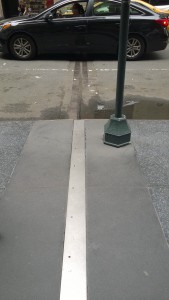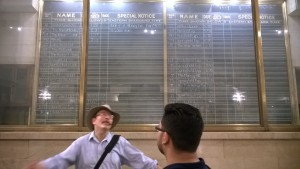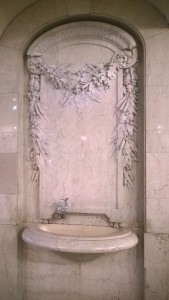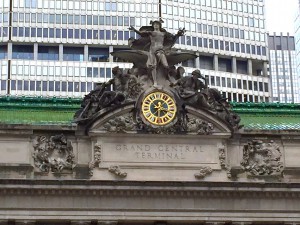Prior to today’s visit to Grand Central Terminal (GCT), I learned many things I wasn’t aware of. First, I was shocked to learn that though Vanderbilt Hall has been restored back to pristine condition, currently, there still remains a homeless population that calls GCT’s lower level home. Though we didn’t get the opportunity visit the lower level, I can only imagine what that it looks like once the afternoon/evening rush hour dies down. It’s really disheartening to know that a landmark of such grandeur and high regard still encompasses the despair it once tried to get rid of. I would assume living there is a better and safer option than living on the streets or in a homeless shelter. I think Metro-North could possibly eliminate this problem by offering them entry-level employment to those willing to work. I don’t know (shrugs); that actually might be a terrible idea. It’s just a possibility I thought of. Secondly, the symbolism behind Coutan’s statue design made me chuckle inside because it made me question whether a woman’s wisdom/logic might have saved GCT from all these issues and the drama surrounding them. Jaqueline Onassis and her efforts are proof of that, and they could have named more than a foyer in her honor. Thirdly, I found it interesting how the neighboring Yale Club (YC) and its architects had to get architectural design approval from Warren and Wetmore in order to secure its location. I guess that goes to show how much clout the Commodore really had, and that architectural autonomy is worth giving up for prime real estate. If you closely look at the YC’s logo, Vanderbilt’s influence becomes very obvious; YC’s logo bears an uncanny resemblance to GCT’s logo.
Category Archives: Uncategorized
The Bowery Boys Podcast
The 45th episode of The Bowery Boys podcast was a general overview of Grand Central from its start as a Depot to the Current Terminal we see today. Having done three tours of the place, The Bowery Boys didn’t really mention much I hadn’t heard before. For Example, they talk about it being a Depot that had train tracks cutting through bare land with horses and houses in what is now midtown Manhattan. Following that, the first few years in the 1900’s saw the creation and use of Grand Central Station. What was interesting about the Station was its short lifetime. Due to all the smoke blocking the site, there was an eventual train crash that lead to the need of addressing the proximity of the smoke and trains to the city; which lead to the creation of tracks underground. Following that they touched on Grand Central Terminal and its history mentioning things such as it being responsible for introducing electricity to the city and the creation of park avenue after the real estate there was sold. One thing I was unaware of was that the windows inside the Terminal were blacked out during WWII. There were also some things on Vanderbilt’s life that were unknown to me. For instance, The Bowery Boys mentioned that he was in the peak of his success in ferries when he decided to venture off into railroads. In addition to this, I did not know he was 75 years old when he started buying out railroad companies and land to build Grand Central.
GCT Tour 6/16/2016
Today’s tour was interesting in that we got to learn more about the design and in-depth history of Grand Central in its early days. The fact that Grand Central was purposely place in mid-town because it was once unused land away from the city, and, likewise, the way Grand Central used that land later on to gain funds were both interesting facts. Another thing that I learned was that the Tiffany clock on the front of GCT, at 14ft in diameter, is the largest Tiffany clock in the world. Lastly, I found it surprising to see those long plates on the ground when we walked on the bridge streets over the trains.
2nd tour
Today’s tour was interesting i learned a lot more information about the outside of the building in detail. Today i learned that the sculpture that is on top of the building who is Hercules which is the god of strength, the one whose next to him is mineve who represents mythology and the the messenger who is the god of commerce; The messenger represent transportation. Also it was interesting to know that when we was outside we were actually 400 feet above the underground railroads. Another interesting fact was the number six on the clock on top of Grand Central Terminal is an a door for those who does work on the clock and in addition the clock was manufactured by Tiffany co. I appreciate the second visit because i got to take a lot more pictures gain more information from the last visit and additional information,
2nd Official Tour of GCT
 I must admit that each and every single time I enter GCT I discover something new. Out tour guide today, Anthony Robins has shown us things we had not seen in previous tours. The image shown is reminiscent of the walking bridges that were built over the railroads before going underground.
I must admit that each and every single time I enter GCT I discover something new. Out tour guide today, Anthony Robins has shown us things we had not seen in previous tours. The image shown is reminiscent of the walking bridges that were built over the railroads before going underground. The missing Chalkboard. I have done extensive research, in the time allotted for our first site report, trying to find this classic chalkboard displaying the time schedules of arrivals and departure. Thank you Tony for showing us that one still exists in preservation.
The missing Chalkboard. I have done extensive research, in the time allotted for our first site report, trying to find this classic chalkboard displaying the time schedules of arrivals and departure. Thank you Tony for showing us that one still exists in preservation. Today we also learned about the various artists who contributed various parts of GCT. This sculpted water fountain was designed by Sylvian Salieres (accent on the 1st “e”). During the many times I drank water from this fountain , I could not resist to admire this “sculpture.” At one time or another I would wonder who was involved in making this master piece–now I know.
Today we also learned about the various artists who contributed various parts of GCT. This sculpted water fountain was designed by Sylvian Salieres (accent on the 1st “e”). During the many times I drank water from this fountain , I could not resist to admire this “sculpture.” At one time or another I would wonder who was involved in making this master piece–now I know.
Tina Brown. Grand Central Terminal
I really enjoyed our third time visiting grand central terminal because it gave us perfect congruent information that was not discussed before. Also we were able to get a more insight of the outside which is important because there is a lot more to Grand Central terminal then the inside such as the tour we had with dan. We were able to get explanation of the buildings around in such as the met life building which is formally known as pan-am which went bank rupt. My favorite part of the tour was the beginning and that was because from where we were standing on Pershing square (park Ave) also intersecting east 41st we were able to see large building but what stood out more is that at the point if you’re standing on that corner and looking at Grand Central Terminal, If you move 90 degrees to your left you will also see another short building and that is the New York Public Library. My second favorite thing was being able to visualize park Ave as the train yard that was there before on page 2 or 3of the pan flit that we were given. This train yard was 4-5 blocks long and took up park Ave. The third time I enjoyed was how we left Grand Central Terminal but when we exited we saw that Grand Central Terminal was to the left off is and we were on top of a building that used to be a hotel. Overall the experience was a great one, I got to learn more that I could apply to my research and knowledge of Grand Central Terminal.
Transit Museum / Archive Visit
Just a reminder that we will meet at the Transit Museum & Archive on Friday. Please arrive ON TIME for your scheduled archival appointment (at 12:00, 1:00, 2:00, or 3:00pm). I will be at the archives, which are located at 130 Livingston Street (across the street from the Museum), all afternoon. You should plan to spend 1 hour in the archives and AT LEAST 1 hour in the museum. Your post-visit reflection blog is due on Monday.
The William Wilgus Papers
William John Wilgus was a civil engineer involved in numerous railroad constructions during the turn of the century; his most notable project being his involvement in Grand Central Station. During his career, William Wilgus created records of his work throughout various projects where he held roles such as: supervisor, advisor, chief engineer, director, researcher, general, and chairmen. Together, along with other documents of his merits, these records form a collection that is now known as The William Wilgus Papers. A total of eight, The William Wilgus Papers are arranged as groupings (series) of records based on the specific project/period-of-work they are related to; making the content within each series self-explanatory. To clarify this, the series, starting from I to VII, consists of I. New York Central & Hudson River Railroad, II. American Expeditionary Forces – Transportation Corps, III. Private Consulting Practice, IV. Public Service Activities, V. American Society of Civil Engineers, VI. Writings, Research Notes, and Related Correspondence, VII. Artifacts and Oversize Material, and an eighth grouping called General Client Files. Furthermore, The NYPL (New York Public Library) Archives website also lists important names, subjects, occupations, and material types mentioned. You can find The William Wilgus Papers at the Stephen A. Schwarzian Building inside the Manuscripts and Archives Division.





